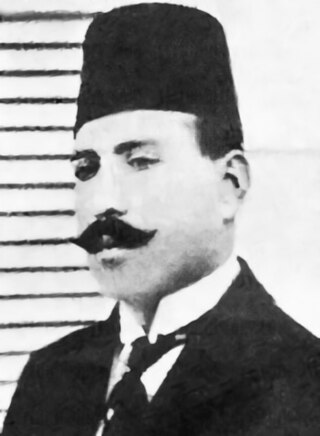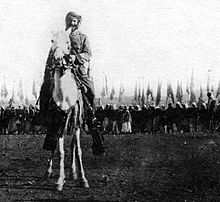
The Great Syrian Revolt, also known as the Revolt of 1925, was a general uprising across the State of Syria and Greater Lebanon during the period of 1925 to 1927. The leading rebel forces initially comprised fighters of the Jabal Druze State in southern Syria, and were later joined by Sunni, Druze and Shiite and factions all over Syria. The common goal was to end perceived French occupation in the newly mandated regions, which passed from Turkish to French administration following World War I.
The al-Atrash, also known as Bani al-Atrash, is a Druze clan based in Jabal Hauran in southwestern Syria. The family's name al-atrash is Arabic for "the deaf" and derives from one the family's deaf patriarchs. The al-Atrash clan migrated to Jabal Hauran in the early 19th century, and under the leadership of their sheikh (chieftain) Ismail al-Atrash became the paramount ruling Druze family of Jabal Hauran in the mid-19th century, taking over from Al Hamdan. Through his battlefield reputation and his political intrigues with other Druze clans, Bedouin tribes, Ottoman authorities and European consuls, Ismail consolidated al-Atrash power. By the early 1880s, the family controlled eighteen villages, chief among which were as-Suwayda, Salkhad, al-Qurayya, 'Ira and Urman.

Sultan al-Atrash was a Syrian Druze nationalist who commanded the Great Syrian Revolt against France and its State of Syria.

Adham Khanjar (1890–1922) was a Lebanese Shia Muslim revolutionary and Syrian nationalist who participated in guerilla warfare against the forces of the French occupation of Lebanon and Syria, and the attempt to assassinate General Gouraud, the French High Commissioner.

Al-Kafr is a village in as-Suwayda Governorate in southern Syria. It is located 8 km to the southeast of as-Suwayda. It is known for its forest and good wine, and it was the site of a number of battles during the 19th and 20th centuries. According to the Syria Central Bureau of Statistics, al-Kafr had a population of 7,458 in the 2004 census.
Al Hamdan is a Druze clan based in Jabal al-Druze, a mountainous region in southeastern Syria. They were among the earliest Druze settlers in Jabal Hauran and were the dominant local force in that region between their establishment there in 1711 and circa 1860, when the al-Atrash clan became the prominent Druze power.

The Battle of al-Mazra'a was one of the major battles of the Great Syrian Revolt, that led to the spread of the rebellion throughout the French Mandate of Syria. It was fought on 2–3 August 1925 between Druze and Bedouin rebels led by Sultan Pasha al-Atrash and a heavily armed French force of the Army of the Levant near the town of al-Mazraa, around 12 kilometres (7.5 mi) northwest of the city of al-Suwayda.

The Hauran Druze Rebellion was a violent Druze uprising against Ottoman authority in the Syrian province, which erupted in 1909. The rebellion was led by the al-Atrash family, in an aim to gain independence, but ended in brutal suppression of the Druze, significant depopulation of the Hauran region and execution of the Druze leaders.
Busra al-Harir is a town in southern Syria, part of the Daraa Governorate situated in the Hauran plain. It is located northeast of Daraa and northwest of as-Suwayda. Nearby localities include Maliha al-Atash to the southeast, al-Shaykh Maskin to the east, Izra to the northeast, Harran to the northwest, Najran to the west, al-Mazraa to the southwest and Nahitah to the south. In the 2004 census by the Central Bureau of Statistics (CBS) Busra al-Harir had a population of 13,315.
Al-Mazraa, also known as as-Sijn is a village in southeastern Syria, administratively part of the as-Suwayda Governorate, located 12 kilometers northwest of as-Suwayda. Nearby localities include al-Hirak, Khirbet Ghazaleh and Da'el to the west and Umm Walad and Bosra to the south. According to the Syria Central Bureau of Statistics (CBS), al-Mazraa had a population of 2,596 in the 2004 census. The town is also the administrative center of the al-Mazraa nahiyah of the al-Suwayda District which consists of 12 villages with a combined population of 16,627.
Umm Walad is a town in southern Syria, administratively part of the Daraa Governorate, located east of Daraa in the Hauran region. Nearby localities include Ira to the southeast, Jabab to the south, al-Musayfirah to the southwest, al-Karak to the northwest, al-Thaalah to the north and al-Suwayda to the northeast. According to the Syria Central Bureau of Statistics (CBS), Umm Walad had a population of 7,547 in the 2004 census.
Al-Qurayya is a town in southern Syria, administratively part of the al-Suwayda Governorate, located south of al-Suwayda. Nearby localities include Bosra to the southwest, Hout to the south, Salkhad to the southeast, al-Kafr, Hibran and Sahwat al-Khudr to the northeast, Sahwat Bilata and Rasas to the north and 'Ara and al-Mujaymer to the northwest. According to the Syria Central Bureau of Statistics (CBS), al-Qurayya had a population of 6,789 in the 2004 census. The town is also the administrative center of the al-Qurayya nahiyah which consists of four towns with a combined population of 9,892.

Al-Musayfirah is a town in southern Syria, administratively part of the Daraa Governorate, located east of Daraa and 37 kilometers southeast of Damascus. Nearby localities include Kahil to the southwest, al-Jiza to the south, al-Sahwah to the southeast, 'Ara to the east, Umm Walad to the northeast, al-Karak to the north, al-Ghariyah al-Sharqiyah to the northwest and Saida to the west. Al-Musayfirah has an area of 705 hectares. According to the Syria Central Bureau of Statistics, al-Musayfirah had a population of 10,466 in the 2004 census. It is the administrative center of the al-Musayfirah nahiyah ("subdistrict") which consisted of four localities with a collective population of 32,473 in 2004. In recent times its population was estimated to be about 13,600 in 2009. Its largest family is the al-Zu'bi (al-Zoubi) clan.
The capture of Salkhad refers to the clash between the Druze rebel forces of Sultan Pasha al-Atrash and a unit of the French Mandate based in Salkhad on 20 July. It would become the first confrontation of the Great Syrian Revolt. Preceding the battle, on 19 July, al-Atrash's forces shot down a French reconnaissance plane, the first shots of the revolt, and captured its injured pilots. The next day, rebels captured Salkhad and its French garrison without facing significant resistance.

Abu Muhammad Hasan al-Kharrat was one of the principal Syrian rebel commanders of the Great Syrian Revolt against the French Mandate. His main area of operations was in Damascus and its Ghouta countryside. He was killed in the struggle and is considered a hero by Syrians.
The 1925 Hama uprising was one of the major events of the Great Syrian Revolt. It involved a rebel assault led by Fawzi al-Qawuqji against Mandatory French security installations in Hama and a subsequent uprising by residents sympathetic to the rebel cause. Heavy French bombardment of the city and the dispatch of reinforcements followed. The hostilities began on 4 October 1925 and negotiations between a delegation of Hama's leading families and the French authorities resulted in the rebels' withdrawal on 5 October.

Nasib al-Bakri was a Syrian politician and nationalist leader in the first half of the 20th century. He played a major role in establishing al-Fatat, an underground organization which sought the independence and unity of the Ottoman Empire's Arab territories. As the chief envoy between al-Fatat and the Hejaz-based Hashemites, al-Bakri became a close aide to Emir Faisal when the latter became King of Syria following the success of the 1916 Arab Revolt. Al-Bakri opposed the establishment of the French Mandate of Syria and became one of the chief commanders of the Great Syrian Revolt, leading the rebels' brief capture of Damascus. He escaped a death warrant in Syria in 1927, but returned the following year after being amnestied.
The Battle of al-Kafr was a military engagement between a French Army column commanded by Captain Gabriel Normand and the local Druze and Bedouin forces of Sultan al-Atrash on 22 July 1925. It occurred at Normand's encampment at the village of al-Kafr, in the southern Syrian region of Jabal al-Druze. The battle was a rout for the French, who were ambushed by Sultan's forces. Sultan's victory prompted an upswing of support for him by the Druze and by the end of July, his forces controlled Jabal al-Druze. The battle precipitated the countrywide Great Syrian Revolt.
Urman is a village in southern Syria, administratively part of the Salkhad District of the al-Suwayda Governorate. It is located south of al-Suwayda and nearby localities include Salkhad to the west, Awas to the south, Malah to the east and Sahwat al-Khudr to the north. In the 2004 census it had a population of 5,735.
Ismail al-Atrash was the preeminent Druze sheikh (chieftain) of Jabal Hauran, a mountainous region southeast of Damascus, in the mid-19th century. His family had moved to the area in the early 19th century. As relative newcomers, they lacked influence in their new home, but Ismail gradually established himself as a power in the village of al-Qurayya and maintained virtual independence from the prominent Druze clans. This was largely due to the battlefield reputation he gained during the campaigns of the Druze leader Shibli al-Aryan in the 1840s. Ismail's leadership of the Druze in territorial struggles with the local Bedouin tribes, relations with the Ottoman authorities and in support of fellow Druze against the Christians during the 1860 Mount Lebanon civil war firmly established his paramountcy. He was a patron of Druze newcomers from Mount Lebanon and with their support he supplanted the Al Hamdan clan as the major force in Jabal Hauran. In 1868, the Ottoman governor of Syria, Rashid Pasha, appointed Ismail as the regional governor (mudir) of Jabal Hauran, drawing the ire of his Druze rivals who formed alliances with the Bedouin tribes and the Muslim peasants of the Hauran plain to restrict Ismail's power. Nonetheless, by then, he controlled 18 villages, many of which were put under the leadership of his eight sons. One of the latter, Ibrahim, became head of the al-Atrash clan following Ismail's death.










